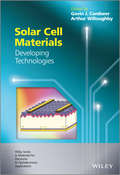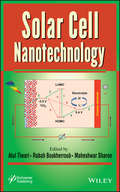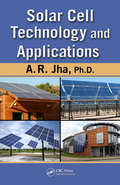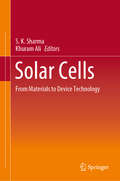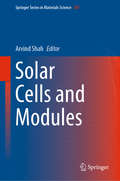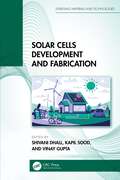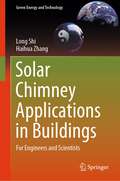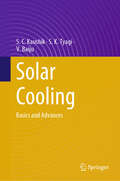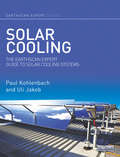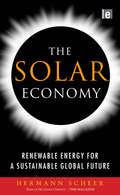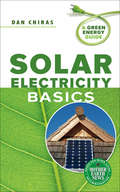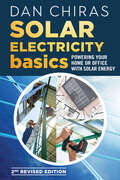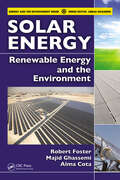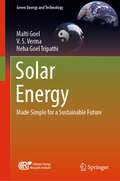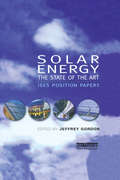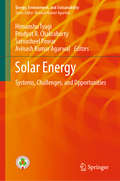- Table View
- List View
Solar Cell Materials
by Gavin J. Conibeer Arthur WilloughbyThis book presents a comparison of solar cell materials, including both new materials based on organics, nanostructures and novel inorganics and developments in more traditional photovoltaic materials. It surveys the materials and materials trends in the field including third generation solar cells (multiple energy level cells, thermal approaches and the modification of the solar spectrum) with an eye firmly on low costs, energy efficiency and the use of abundant non-toxic materials.
Solar Cell Nanotechnology
by Atul Tiwari Rabah Boukherroub Maheshwar SharonFocusing on the cutting-edge technologies available in the field of photovoltaics, Solar Cell Nanotechnology explores the latest research and development activities related to organic, inorganic, and hybrid materials being used in solar cell manufacturing. Several chapters are dedicated to explaining the fundamentals of photovoltaics and nanomaterials utilized in the manufacturing of solar cells. Other essential subjects, such as microcontact printing, plasmonic light trapping, outdoor and indoor efficiency, luminescent solar concentrators, and photon management in photovoltaics, are comprehensively reviewed. Written for a broad audience, this is an essential book for engineers, nanotechnologists, and materials scientists.
Solar Cell Technology and Applications
by A. R. JhaEnergy experts predict that wholesale electricity prices could easily rise 35 to 65 percent by 2015. Add to this the growing need for energy independence and the need to reduce carbon emissions and it is very clear that the development of low-cost renewable energy, such as solar energy, is essential for our economy and our national security. With t
Solar Cells: Types and Applications
by Sandeep Arya Prerna MahajanThis book highlights developments in the field of solar cells. The chapters in this book address a wide range of topics including the spectrum of light received by solar cell devices, the basic functioning of a solar cell, and the evolution of solar cell technology during the last 50 years. It places particular emphasis on silicon solar cells, CIGS-based solar cells, organic solar cells, perovskite solar cells and hybrid solar cells. The book describes in detail the fabrication processes employed for different categories of solar cells. It also provides the characterization techniques utilized in this sector to evaluate the performance of solar cells and the scope of this domain in the future. Overall, it presents the essential theoretical and practical concepts of solar cells in an easy-to-understand manner.
Solar Cells: From Materials to Device Technology
by S. K. Sharma Khuram AliThis book addresses the rapidly developing class of solar cell materials and designed to provide much needed information on the fundamental principles of these materials, together with how these are employed in photovoltaic applications. A special emphasize have been given for the space applications through study of radiation tolerant solar cells. This book present a comprehensive research outlining progress on the synthesis, fabrication and application of solar cells from fundamental to device technology and is helpful for graduate students, researchers, and technologists engaged in research and development of materials.
Solar Cells and Modules (Springer Series in Materials Science #301)
by Arvind ShahThis book gives a comprehensive introduction to the field of photovoltaic (PV) solar cells and modules. In thirteen chapters, it addresses a wide range of topics including the spectrum of light received by PV devices, the basic functioning of a solar cell, and the physical factors limiting the efficiency of solar cells. It places particular emphasis on crystalline silicon solar cells and modules, which constitute today more than 90 % of all modules sold worldwide. Describing in great detail both the manufacturing process and resulting module performance, the book also touches on the newest developments in this sector, such as Tunnel Oxide Passivated Contact (TOPCON) and heterojunction modules, while dedicating a major chapter to general questions of module design and fabrication. Overall, it presents the essential theoretical and practical concepts of PV solar cells and modules in an easy-to-understand manner and discusses current challenges facing the global research and development community.
Solar Cells and Their Applications
by Lewis M. Fraas Larry D. PartainA major update of solar cell technology and the solar marketplaceSince the first publication of this important volume over a decade ago, dramatic changes have taken place with the solar market growing almost 100-fold and the U.S. moving from first to fourth place in the world market as analyzed in this Second Edition. Three bold new opportunities are identified for any countries wanting to improve market position. The first is combining pin solar cells with 3X concentration to achieve economic competitiveness near term. The second is charging battery-powered cars with solar cell-generated electricity from arrays in surrounding areas-including the car owners' homes-while simultaneously reducing their home electricity bills by over ninety percent. The third is formation of economic "unions" of sufficient combined economic size to be major competitors.In this updated edition, feed-in tariffs are identified as the most effective approach for public policy. Reasons are provided to explain why pin solar cells outperform more traditional pn solar cells. Field test data are reported for nineteen percent pin solar cells and for ~500X concentrating systems with bare cell efficiencies approaching forty percent. Paths to bare cell efficiencies over fifty percent are described, and key missing program elements are identified. Since government support is needed for new technology prototype integration and qualification testing before manufacturing scale up, the key economic measure is identified in this volume as the electricity cost in cents per kilowatt-hour at the complete installed system level, rather than just the up-front solar cell modules' costs in dollars per watt.This Second Edition will benefit technologists in the fields of solar cells and systems; solar cell researchers; power systems designers; academics studying microelectronics, semiconductors, and solar cells; business students and investors with a technical focus; and government and political officials developing public policy.
Solar Cells Based on Colloidal Nanocrystals
by Holger BorchertThis book presents a new system of solar cells. Colloidal nanocrystals possess many physical and chemical properties which can be manipulated by advanced control over structural features like the particle size. One application field is photovoltaics where colloidal semiconductor nanocrystals are explored as components of photo-active layers which can be produced from liquid media, often in combination with conductive polymers. The further development of this interdisciplinary field of research requires a deep understanding of the physics and chemistry of colloidal nanocrystals, conducting polymers and photovoltaic devices. This book aims at bridging gaps between the involved scientific disciplines and presents important fundamentals and the current state of research of relevant materials and different types of nanoparticle-based solar cells. The book will be of interest to researchers and PhD students. Moreover, it may also serve to accompany specialized lectures in related areas.
Solar Cells Development and Fabrication (Emerging Materials and Technologies)
by Vinay Gupta Shivani Dhall Kapil SoodThis book covers the basic scientific background of solar cells, their principles, working, growth, operating parameters, commercialization status, manufacturing challenges, and future scope of solar cells. Topics covered range from history and developments of solar cell generation to market growth and different applications of solar cells including in depth knowledge about Si, PSCs, and next generation multilayer bandgap based solar cells and their fabrication techniques with advanced methodology.Key features: Explains solar cells and their growth at different stages Discusses challenges in the fabrication/commercialization of solar cells at the lab and industry levels Combines fundamental, experimental, and theoretical knowledge with industrial needs and engineering design methods Covers the new generation of perovskite solar cells and their synthesis techniques Explores multilayer graded bandgap solar cells and their importance in existing solar technology This book is specifically designed for graduate students and researchers in solar energy technology, cell device, and materials science.
Solar Chimney Applications in Buildings: For Engineers and Scientists (Green Energy and Technology)
by Long Shi Haihua ZhangThis book comprehensively describes the operating principles and theoretical foundations of solar chimneys. It covers current research results, including numerical analysis and mathematical models based on different assumptions. Complying with the application of renewable energy in sustainable buildings, solar chimney has received extensive attention as an indispensable part natural ventilation. This book is a guide to the application of solar chimneys from single zones to multi zones, and it provides a reference source of application for construction practitioners and engineering decision-makers. The design basis and the related basic principles of fluid mechanics and natural ventilation design strategies introduced in this book will also be beneficial to college students.
Solar Cooling: Basics and Advances
by S. C. Kaushik S. K. Tyagi V. BaijuThe book deals with the research activities focussed on solar VAD systems evaluating its merit of compatibility with ozone friendly refrigerants and adoptability with solar energy option. The authors of this book have given more emphasis on discussing various solar cooling VAD systems and its viability for the commercial use. Relevant references on "Solar Cooling: Basics and Advances" has been provided which significantly adopt some of the information for the completeness of the book.
Solar Cooling: The Earthscan Expert Guide to Solar Cooling Systems (Earthscan Expert)
by Paul Kohlenbach Uli JakobCooling buildings is a major global energy consumer and the energy requirement is growing year by year. This guide to solar cooling technology explains all you need to know about how solar energy can be converted into cooling energy. It outlines the difference between heat-driven and photovoltaic-driven systems and gives examples of both, making clear in what situations solar cooling technology makes sense. It includes chapters on: • solar thermal collectors • solar cooling technologies • cold distribution • storage components • designing and sizing • installation, operation and maintenance • economic feasibility • potential markets • case studies. Solar Cooling is for engineers, architects, consultancies, solar thermal technology companies, students and anyone who is interested in getting involved with this technology.
Solar Cooling Technologies (Energy Systems)
by Sotirios Karellas Tryfon C Roumpedakis Nikolaos Tzouganatos Konstantinos BraimakisSolar Cooling Technologies presents a detailed study of the potential technologies for coupling solar energy and cooling systems. Unifies all the various power based solar techniques into one book, investigates tri-generation schemes for maximization of cooling efficiency, especially for small scale applications and offers direct comparison of all possible technologies of solar cooling Includes detailed numerical investigations for potential cooling applications
Solar Drying Systems
by Anil Kumar Om PrakashSolar energy has found its widespread use in direct conversion into electricity either by photovoltaic conversion or through thermal energy, reduction in post-harvest losses, and crop drying. Solar Drying Systems analyzes the fundamentals, principles and applications, heat transfer, elements of drying and solar dryer designs, and related modeling and analysis aspects of solar energy. Discusses both technical and policy-related issues Explores up-to-date status reviews of different solar drying systems Reviews the highlights of present and future solar drying options Includes many figures, solved examples, and tables with problems/exercises at the end of each chapter This book is aimed at senior undergraduate and graduate students in energy engineering.
The Solar Economy: Renewable Energy for a Sustainable Global Future
by Hermann ScheerThe global economy and our way of life are based on the exploitation of fossil fuels, which not only threaten massive environmental and social disruption through global warming but, at present rates of consumption, will run out within decades, causing huge industrial dislocation and economic collapse. Even before then, the conflicts it causes in the Middle East and elsewhere will be frighteningly exacerbated. The alternative exists: renewable energy from renewable sources - above all, solar. Substituting renewable for fossil resources will take a new industrial revolution to avert the worst of the damage and establish a new international order. It can be done, and it can be done in time. The Solar Economy, by one of the world's most effective analysts and advocates, lays out the blueprints, showing how the political, economic and technological challenges can be met using indigenous, renewable and universally available resources, and the enormous opportunities and benefits that will flow from doing so.
Solar Electricity Basics: A Green Energy Guide (Mother Earth News Books for Wiser Living)
by Dan ChirasThe future will be powered by renewables. As we transition away from finite and polluting fossil fuels, clean, reliable, and affordable renewable technologies such as solar electricity will become the mainstay of our energy supply. Solar Electricity Basics provides a clear understanding of electricity and energy. It discusses the types of solar electric system you can choose from, their components, solar site assessment, the installation of photovoltaic systems, and much more. Whether your goal is to lower your energy bill or to achieve complete energy independence, Solar Electricity Basics is the introduction you need.
Solar Electricity Basics: Powering Your Home or Office with Solar Energy
by Dan ChirasA guide to choosing and using solar electricity systems from &“the man who launched a thousand rooftop solar arrays . . . the essential go-to manual&” (John D. Ivanko and Lisa Kivirist, coauthors of ECOpreneuring). As we look for safer, more economical, and more sustainable ways to meet our needs for electricity—and as more and more electric cars hit the road—solar has become an increasingly popular option. With Solar Electricity Basics, renewable energy expert Dan Chiras offers a concise and up-to-date guide covering all the essentials. It explores:How to size, cost, and choose the right system, including off-grid vs. grid-tied vs. grid-tied with battery backupWhere to mount a system for maximum performanceWhat type of modules and inverters to buyHow to install and maintain batteriesCost vs. benefit for solar electric systemsHow to connect to the grid, and what type of net metering your area offersSolar Electricity Basics is an indispensable guide for homeowners, business owners, builders, and students for figuring out solar electricity quickly and easily.
Solar Energetic Particles
by Donald V. ReamesThis concise primer introduces the non-specialist reader to the physics of solar energetic particles (SEP) and systematically reviews the evidence for the two main mechanisms which lead to the so-called impulsive and gradual SEP events. More specifically, the timing of the onsets, the longitude distributions, the high-energy spectral shapes, the correlations with other solar phenomena (e. g. coronal mass ejections), as well as the all-important elemental and isotopic abundances of SEPs are investigated. Impulsive SEP events are related to magnetic reconnection in solar flares and jets. The concept of shock acceleration by scattering on self-amplified Alfv#65533;n waves is introduced, as is the evidence of reacceleration of impulsive-SEP material in the seed population accessed by the shocks in gradual events. The text then develops processes of transport of ions out to an observer. Finally, a new technique to determine the source plasma temperature in both impulsive and gradual events is demonstrated. Last but not least the role of SEP events as a radiation hazard in space is mentioned and a short discussion of the nature of the main particle telescope designs that have contributed to most of the SEP measurements is given.
Solar Energy (Let's Explore Global Energy Ser.)
by David ArmentroutIntroduces Solar Energy and its positive or negative impact on the environment, particularly our future. <P><P>Lexile Measure: 950L
Solar Energy: Renewable Energy and the Environment (ISSN)
by Robert Foster Majid Ghassemi Alma CotaDrawing on the authors' extensive research and project implementation around the globe, this book provides detailed knowledge for converting solar radiation into a suitable energy supply. It presents technical fundamentals to give a clear understanding of how solar energy can be captured for later use. The authors examine thermosolar collectors, photovoltaics modules, and other important types of solar receivers as well as cover typical cost-effective applications, including water pumping, residential electrification, lighting, small-scale irrigation, and more. Examples, case studies, and lessons learned from technical failures illustrate how to best implement solar energy projects.
Solar Energy: Made Simple for a Sustainable Future (Green Energy and Technology)
by Malti Goel V. S. Verma Neha Goel TripathiThis book presents the achievements made in solar energy and prospects in achieving solar potential in India. It covers the historical perspectives, innovations and myriad applications of solar energy in its different forms. The book discusses solar devices and covers both solar photovoltaics and solar thermal energy and includes both heat and electricity applications. Solar policies in India, solar research, technologies, large scale adoption as well as future trends are also discussed. This book will be useful for researchers and professionals with interests in technological, economical and policy developments in solar energy driven power industry.
Solar Energy: The State of the Art
by Jeffrey GordonIt is rare that a book draws together the knowledge and experience of scientists, each a world leader in his or her discipline, to create a work that presents the state of the art in a field as rich and diverse as solar energy. In Solar Energy - the State of the Art this aim has been achieved. The book comprises twelve individual chapters, each dedicated to one of the major solar energy sub-disciplines and authored by an internationally recognised expert in the field. Areas covered range from solar radiation and meteorology, solar collectors and concentrators, solar energy and the built environment, to solar thermal electricity, photovoltaics, wind energy and the potential cost of ignoring solar energy resources. The papers examine the technology and field in question, discuss the rudiments and major applications, review the current science and technology and explore the remaining challenges for the future. Solar Energy - the State of the Art is an essential reference work for all solar energy practitioners, students, researchers and engineers wishing to gain a broad-based understanding of the theory, technology, applications and issues surrounding the broad, interdisciplinary field of solar energy. The book will form an important component of any library's solar energy holding and will be of particular benefit as an academic reference, as well as being of practical value to professionals who wish to gain a clear understanding of the concepts required to move forward in this field. Published with ISES.
Solar Energy
by Christian A. Gueymard Christoph Richter Daniel LincotGathering some 30 entries from the Encyclopedia of Sustainability Science and Technology, this book presents fundamental principles and technologies for sustainably harnessing solar energy. Covers photovoltaics, solar thermal energy, solar radiation and more.
Solar Energy: Technologies, Design, Modeling, and Economics (Power Systems)
by Ibrahim Moukhtar Adel Z. El Dein Adel A. Elbaset Yasunori MitaniThis book opens with a brief introduction to renewable energy and the advantages of solar energy systems, an overview of concentrated solar power (CSP) system technologies and modeling, and the application of artificial neural network (ANN) technologies in various solar field systems. Later chapters cover data and operation methods of central tower receiver power plants (CTRPP), important models of ANN techniques used in solar energy fields, accurate methods for modeling CTRPP, the economics of solar energy systems, the CSP impacts on the penetration level of photovoltaic (PV) systems, and a look at the reliability of systems using case studies on PV systems and hybrid PV and CSP systems.Provides an introduction to renewable energy and the advantages of solar energy systemsOutlines methods for modeling central tower receiver power plantsIncludes case studies on photovoltaic (PV) and hybrid PV and concentrated solar power systems
Solar Energy: Systems, Challenges, and Opportunities (Energy, Environment, and Sustainability)
by Himanshu Tyagi Prodyut R. Chakraborty Satvasheel Powar Avinash Kumar AgarwalThis book covers challenges and opportunities related to solar-energy based systems. It covers a wide variety of topics related to solar energy, including applications-based systems such as solar thermal systems that are focused on drying, desalination, space cooling, refrigeration, and processing; recent advances in solar cells (DSSC) and photovoltaics; technologies for storage of energy (both sensible heating as well as latent heating); and the design of concentrated solar receivers. The information is presented in the context of the overall global energy utilization, and the role of solar energy has been highlighted. The contents of this book will be of interest to researchers, professionals, and policymakers alike.
